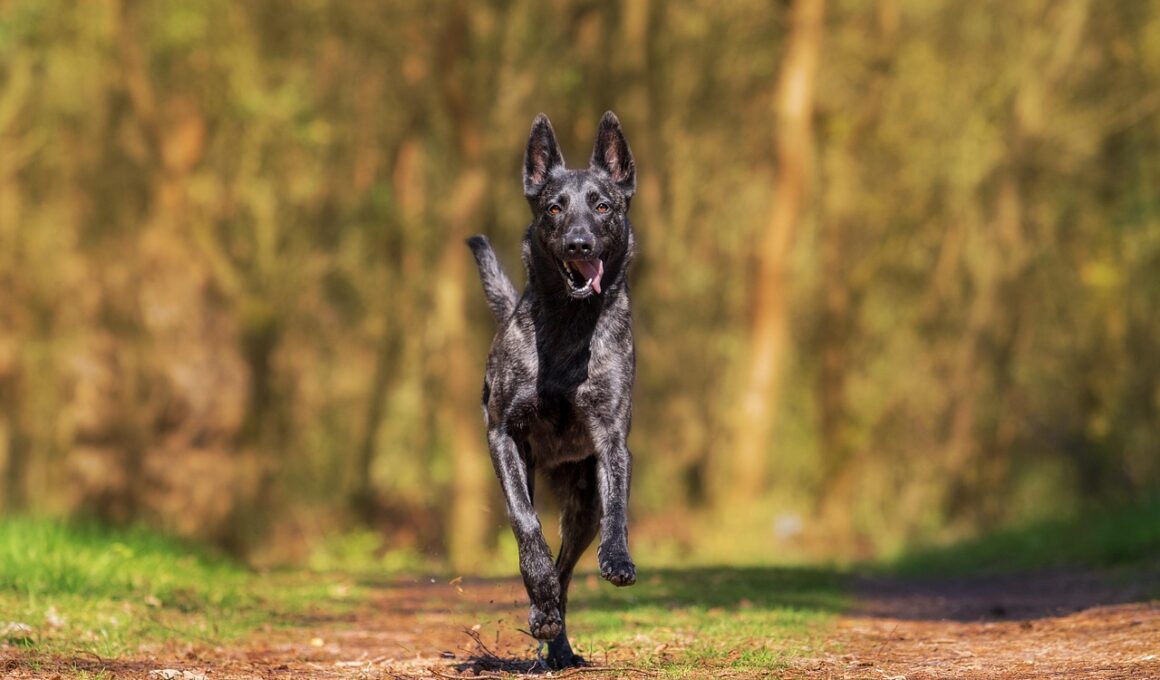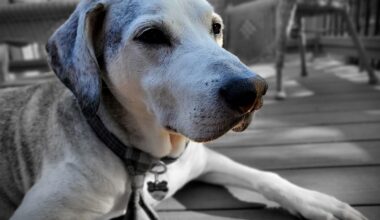Safe Ways to Photograph Dogs in Public Parks
When photographing dogs in public parks, ensuring their safety is paramount. Start by assessing the environment; look for potential hazards like deep water, busy paths, and wildlife. Before taking any photos, familiarize yourself with the dog’s behavior and preferences. Is the dog friendly with other dogs? How does it react to people? Knowing these details allows you to predict potential challenges during the shoot. Make sure to keep the dog’s leash handy, as it may need to be secured for safety. If possible, select a quieter area of the park to minimize distractions and stress for your subject. Also, inform fellow park-goers about your photo shoot so they can respect the dog’s space. Always reward the dog with treats after moments of stillness to create positive associations with the shoot. This encourages compliance and helps maintain a calm atmosphere. Prepare for quick actions by keeping your camera settings optimized. Always be mindful of weather conditions that could affect the dog’s comfort too. Being prepared for weather changes can greatly enhance the photography experience.
Many factors can contribute to creating a conducive environment for dog photography in parks. Ensure that your equipment is dog-friendly and won’t harm the animal or distract them. Using a long zoom lens can be advantageous as it allows you to maintain distance while capturing candid moments. This reduces pressure on the dog and helps you avoid startling them. You should also consider the time of day when planning your shoot; early mornings or late afternoons provide the best natural light and fewer crowds. This lighting creates beautiful images while keeping dogs calm. Moreover, involving their owner in the shoot can have a great positive impact. Owners can help engage the dog during the session, making it easier for you to capture genuine expressions. However, always advise them about your methods regarding treats or toys. Also, keep in mind not to force the dog into any uncomfortable positions. Observe their natural behavior instead, as it sends a message of comfort and trust. This leads to better photographs that embody the dog’s personality.
Understanding Dog Behavior for Better Photography
It’s crucial to understand basic dog behavior when planning your shoot. Dogs communicate their feelings through body language. An alert dog with ears up indicates interest, while a dog lacing in its tail may signal fear. Understanding these signs is crucial to capturing authentic moments. Be patient as the dog acclimatizes to the surrounding environment. This will allow it to feel at ease and present its natural behavior. Introduce props or toys that the dog loves to create familiarity. Interactive playtime can also become part of your photo session, leading to dynamic shots. While photographing, focus on getting down to the dog’s level to create engaging perspectives. This alteration in height can produce captivating compositions and make the images feel personal. Keep an eye on other park visitors to ensure interactions are safe. Be aware that some dogs may be territorial, leading to potential conflicts. If any dog appears agitated, it’s best to pause the shoot and allow it time to relax. Always prioritize creating a risk-free environment for the dogs you photograph.
Consider the types of shots you wish to achieve and plan accordingly. Candid shots are common in public parks but require patience. Capture the moments when the dog is exploring, playing, or interacting freely. Framing is vital; look for natural frames formed by trees or other elements in the park. This can add depth to your images and draw focus to the subject. Instead of forcing a pose, wait for an interested look or an action shot. Action photography can be thrilling, capturing the essence of a dog in motion. Quick shutter speeds will be necessary for this, so practice knowing your camera’s configuration. Additionally, never forget about the equipment you’re using; a reliable camera and a portable reflector can enhance lighting. When using a reflector, ensure that it won’t disturb the dog. It’s all about making the environment less stressful for the participating dog. Configuration of your camera can also be unique based on each dog’s behavior. Know when to capture close-ups for portraits and when to capture wider shots for context. This balance will enhance storytelling.
Protecting Dogs from Potential Dangers
All pets deserve a safe space, and public parks can harbor unexpected dangers. Be on the lookout for sharp objects, chemicals, or aggressive animals. It’s critical to conduct a preliminary inspection of the area where the shoot will take place. Keep an eye out for any signs indicating the presence of wild animals, including aggressive ones. This could lead to incidents if a dog is approached unexpectedly. In terms of preventing tick-borne diseases, ensure dogs are up-to-date with preventive treatments before arriving at the park. Checking the dog for ticks after your photo shoot is equally important. Also, familiarize yourself with common local wildlife; understanding threats can minimize risks. When photographing near water features, supervise the dog closely and provide assistance if it ventures near slippery zones. Staying alert will prevent accidents and maximize a successful shoot. Always set boundaries regarding where the dog is allowed to roam freely. Make sure the owner understands these limits to foster a secure shooting environment.
After your session, don’t forget to evaluate the photographs taken. Organize the final shots into a gallery that reflects the dog’s personality. In sharing their story through photography, highlight special quirks that reveal its character. Whether it’s joyful leaps or focused stares, these moments connect with audiences. Consider seeking consent from the dog owner before showcasing images, especially if they contain identifiable features of the park. Sharing responsibly is vital, both for the dog’s safety and privacy of the owners. Create a follow-up plan with the owner for sharing and distributing the photographs. Collaborating on social media promote both the dog’s story and your work. Consider creating prints or digital copies for the owner to cherish those beautiful moments. This can foster good relationships and open opportunities for future photography projects. Engaging with the audience through storytelling will elevate your dog photography experience. These efforts will not only make your work stand out but also broaden awareness about responsible dog ownership.
Conclusion of Safe Dog Photography
By following safety tips and understanding dog behavior, photographing dogs in public parks can become a rewarding endeavor. This ensures the sessions are enjoyable for both the dog and the photographer while leading to stunning images. Implementing these safety measures fosters a sense of comfort and willingness in dogs, allowing their true personalities to shine through the lens. Always prioritize the well-being of dogs during shoots by remaining vigilant. Each unique dog brings incredible stories that deserve to be documented carefully. Remember that patience is crucial whenever capturing canine subjects. Celebrate the bond between humans and dogs through photography and sharing those moments artfully. It cultivates a deeper appreciation for these adored companions. As each experience can inspire others in the dog photography community, passing on knowledge also builds a collaborative spirit. Safety should always be paramount; ensuring a safe experience cultivates respect for nature and the parks we use. By applying these safe photography practices, you ensure the well-being of dogs you photograph and enrich your own skills as a photographer.



